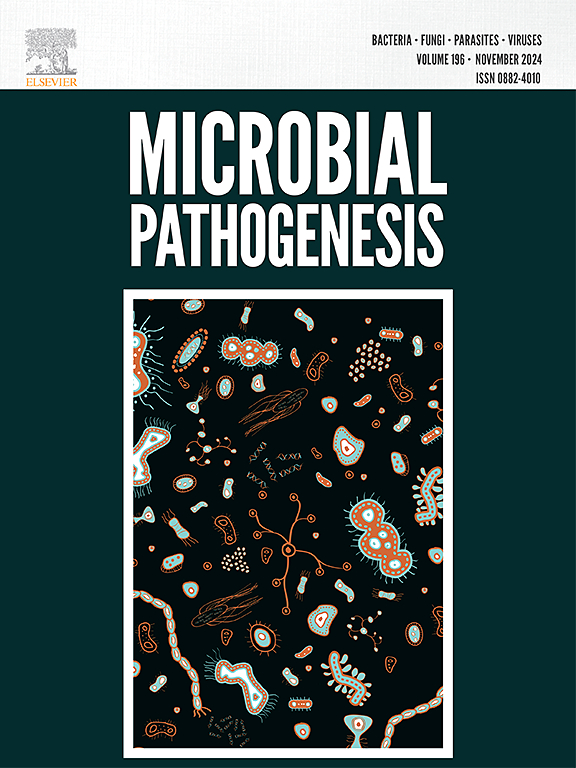叶坪细菌外代谢产物抑制轴索黄单胞菌。石榴:细菌枯萎病管理的代谢组学和基因组学见解。
IF 3.5
3区 医学
Q3 IMMUNOLOGY
引用次数: 0
摘要
细菌性枯萎病,由黄单胞菌引起。石榴,仍然是一个重要的制约石榴种植,需要可持续的替代品,以化学和抗生素为基础的控制。本研究通过综合代谢组学、挥发性、体外和温室分析,对从石榴叶面分离的24株附生细菌进行了生物防治潜力评价。LC-MS/MS分析显示芽孢杆菌中存在Bacillomycin D、Fengycin和Iturin A等生物活性代谢物;大泌乳素(6.3 μg/mL)、大泌乳素W (4.1 μg/mL)、棕榈酸蔗糖(2.8 μg/mL);pantoia中的Cyclo(l-Pro-l-Tyr),色氨酸,Dapdiamide A和B, pantoia中的pantoia A和B。GC-MS分析发现(E)-3- butylidene -4,5-dihydroisobenzofuran-1(3H)-one是多个分离株的主要挥发性化合物。其中,Pantoea分散菌Pg-Slp6表现出最高的磷酸盐增溶率(84.5 μg/mL)、吲哚-3-乙酸产量(28.6 μg/mL)、铁载体活性(CAS指数0.86)和显著的致病菌抑制作用(体外抑制72.3%),是最有前途的菌株;在温室试验中疾病减少61.5%)。代谢物介导的生物测定证实了axonopodis pv的完全抑制。解淀粉芽孢杆菌P2-1和分散芽孢杆菌Pg-Slp6的次生代谢产物。P.分散菌Pg-Slp6的全基因组测序揭示了与次生代谢物生物合成、外源降解和植物生长促进性状相关的基因簇,证实了其多功能性。基于100个保守的蛋白质编码基因的系统发育分析将P. dispera Pg-Slp6置于一个独特的进化支中,强调了其独特的基因组身份。这些发现证实了P. dispera Pg-Slp6是开发适合叶面的微生物配方的有力候选者,旨在生态有效地管理石榴细菌性枯萎病。本文章由计算机程序翻译,如有差异,请以英文原文为准。

Phylloplane bacterial exometabolites suppress Xanthomonas axonopodis pv. punicae: Metabolomic and genomic insights for bacterial blight management in pomegranate
Bacterial blight, caused by Xanthomonas axonopodis pv. punicae, remains a significant constraint to pomegranate cultivation, necessitating sustainable alternatives to chemical and antibiotic-based control. In this study, 24 epiphytic bacterial strains isolated from the pomegranate phylloplane were evaluated for their biocontrol potential through integrated metabolomic, volatilomic, in vitro, and greenhouse analyses. LC-MS/MS profiling revealed the presence of bioactive metabolites such as Bacillomycin D, Fengycin, and Iturin A in Bacillus spp.; Macrolactin (6.3 μg/mL), Macrolactin W (4.1 μg/mL), and sucrose palmitate (2.8 μg/mL) in Erwinia; and Cyclo (l-Pro-l-Tyr), Tryptophol, Dapdiamide A and B, and Pantocin A and B in Pantoea. GC-MS analysis identified (E)-3-Butylidene-4,5-dihydroisobenzofuran-1(3H)-one as a dominant volatile compound across multiple isolates. Among the strains, Pantoea dispersa Pg-Slp6 emerged as the most promising, exhibiting the highest phosphate solubilization (84.5 μg/mL), indole-3-acetic acid production (28.6 μg/mL), siderophore activity (CAS index 0.86), and significant pathogen suppression (72.3 % inhibition in vitro; 61.5 % disease reduction in greenhouse trials). Metabolite-mediated bioassays confirmed complete inhibition of X. axonopodis pv. punicae by secondary metabolites from Bacillus amyloliquefaciens P2-1 and P. dispersa Pg-Slp6. Whole-genome sequencing of P. dispersa Pg-Slp6 revealed gene clusters associated with secondary metabolite biosynthesis, xenobiotic degradation, and plant growth-promoting traits, affirming its multifunctional capabilities. Phylogenetic analysis based on 100 conserved protein-coding genes placed P. dispersa Pg-Slp6 in a distinct clade, underscoring its unique genomic identity. These findings establish P. dispersa Pg-Slp6 as a robust candidate for developing phylloplane-adapted microbial formulations aimed at the eco-friendly and effective management of bacterial blight in pomegranate.
求助全文
通过发布文献求助,成功后即可免费获取论文全文。
去求助
来源期刊

Microbial pathogenesis
医学-免疫学
CiteScore
7.40
自引率
2.60%
发文量
472
审稿时长
56 days
期刊介绍:
Microbial Pathogenesis publishes original contributions and reviews about the molecular and cellular mechanisms of infectious diseases. It covers microbiology, host-pathogen interaction and immunology related to infectious agents, including bacteria, fungi, viruses and protozoa. It also accepts papers in the field of clinical microbiology, with the exception of case reports.
Research Areas Include:
-Pathogenesis
-Virulence factors
-Host susceptibility or resistance
-Immune mechanisms
-Identification, cloning and sequencing of relevant genes
-Genetic studies
-Viruses, prokaryotic organisms and protozoa
-Microbiota
-Systems biology related to infectious diseases
-Targets for vaccine design (pre-clinical studies)
 求助内容:
求助内容: 应助结果提醒方式:
应助结果提醒方式:


